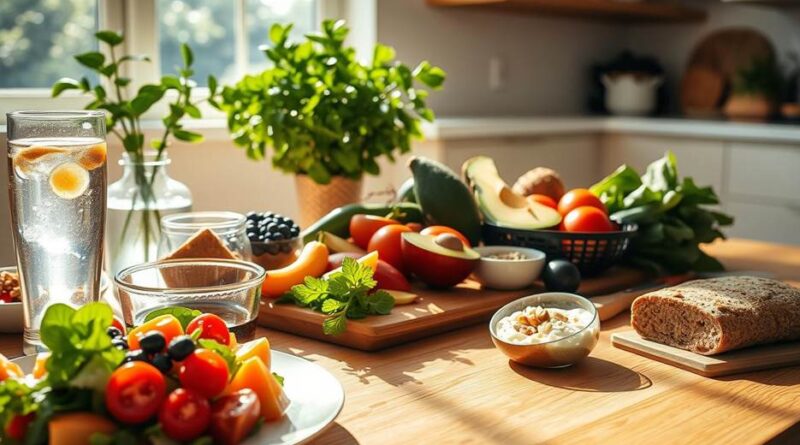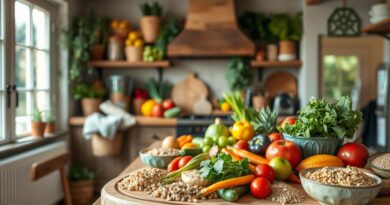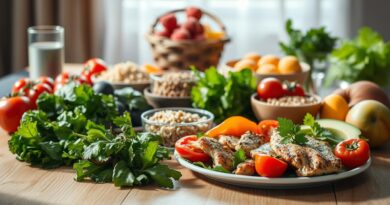Healthy Eating Tips for Weight Loss
Are you struggling to achieve your weight loss goals? You’re not alone. Many of us find navigating the complex dieting world challenging, often leading to frustration and disappointment. However, by following practical and sustainable healthy eating tips for weight loss you can build lasting habits that support both your well-being and long-term success.

Focusing on nutrient-rich foods and developing a healthier relationship with food can set you up for long-term success. This article will provide practical, healthy eating tips to support your weight loss journey and help you achieve a more balanced and fulfilling lifestyle.
Key Takeaways
- Focus on nutrient-rich foods for sustainable weight loss
- Develop a healthier relationship with food
- Avoid fad diets and quick fixes
- Emphasize whole foods over processed options
- Stay hydrated to support overall well-being
Adopting Healthy Eating Tips for Weight Loss
Embarking on a weight loss journey can be exciting and intimidating, but understanding the basics can make all the difference. To achieve your weight loss goals, you need to comprehend the science behind it and follow some important weight loss tips.
The Science Behind Weight Loss
Weight loss is fundamentally about creating a caloric deficit, consuming fewer calories than your body burns. This process is intricately linked to your metabolism.
Metabolism Basics
Your metabolic rate determines how many calories you burn at rest. Factors such as age, gender, and genetics influence your metabolic rate.
How Your Body Burns Calories
Your body burns calories through basal metabolic rate (BMR), physical activity, and thermogenesis. Understanding these components can help you tailor a healthy diet plan.
Setting Realistic Expectations
Setting achievable goals is crucial for successful weight loss. Unrealistic expectations can lead to disappointment.
Healthy Rate of Weight Loss
A healthy weight loss rate is 1-2 pounds per week. This pace may seem slow, but it’s more sustainable and less likely to result in rebound weight gain.
Why Healthy Eating Matters More Than Exercise
While exercise is important, healthy eating plays a more significant role in weight loss. Nutritional guidelines recommend focusing on whole foods, portion control, and balanced meals.
| Weight Loss Factor | Importance | Tips |
| Diet | High | Focus on whole foods, control portions |
| Exercise | Medium | Combine cardio with strength training |
| Metabolism | High | Understand your BMR and adjust accordingly |

The Fundamentals of Caloric Balance
Caloric balance is crucial for weight loss, as it determines whether you lose, gain, or maintain your current weight. Understanding this concept is essential for creating an effective weight loss plan.
Calculating Your Daily Caloric Needs
To start, you need to calculate your daily caloric needs. This involves understanding your Basal Metabolic Rate (BMR) and Total Daily Energy Expenditure (TDEE).
BMR and TDEE Explained
BMR is the number of calories your body needs to function at rest, while TDEE includes the calories you burn during physical activity. Online calculators can help you determine these values.
Creating a Sustainable Caloric Deficit
A caloric deficit occurs when you consume fewer calories than your TDEE. Aiming for a deficit of 500 calories daily can lead to a sustainable weight loss of about 1 pound per week.
The 500-Calorie Rule
Reducing your daily intake by 500 calories is a straightforward strategy for weight loss. However, ensuring you’re still consuming enough calories to support your bodily functions is crucial.
Why Extreme Restriction Backfires
Severely restricting calorie intake can lead to metabolic adaptation, in which the body slows down its metabolism to conserve energy.
Metabolic Adaptation
This adaptation makes it harder to lose weight over time. A more balanced approach to the caloric deficit is essential for long-term success.
| Caloric Deficit | Weekly Weight Loss |
| 250 calories | 0.5 pounds |
| 500 calories | 1 pound |
| 1000 calories | 2 pounds |

Essential Macronutrients for Weight Loss
Achieving weight loss involves more than just cutting calories; it requires a balanced intake of essential macronutrients. Your diet plays a crucial role in determining the success of your weight loss efforts.
Protein: Your Weight Loss Ally
Protein is vital for weight loss as it helps build and repair muscles, keeping you full and satisfied. This reduces the likelihood of overeating.
Optimal Protein Sources
You can find high-quality protein in lean meats like chicken and turkey, fish, eggs, dairy products, and plant-based sources such as beans, lentils, and tofu.
How Much Protein You Need Daily
The daily protein requirement varies based on age, sex, weight, and activity level. For weight loss, aiming for 0.8 to 1 gram of protein per kilogram of body weight is generally recommended.
Healthy Fats That Support Weight Management
Not all fats are created equal. Healthy fats are crucial for hormone production, brain function, and vitamin absorption.
Incorporating Omega-3s and Monounsaturated Fats
You can incorporate healthy fats into your diet through foods rich in omega-3s, like salmon and walnuts, and monounsaturated fats in avocados and olive oil.
Smart Carbohydrate Choices
Carbohydrates are a primary energy source, but choosing the right type is crucial for weight loss.
Complex vs. Simple Carbs
Complex carbohydrates, such as whole grains, fruits, and vegetables, are rich in fibre and nutrients and keep you fuller for longer. In contrast, simple carbohydrates like sugary snacks cause a spike in blood sugar followed by a crash, leading to increased hunger.

By focusing on a balanced protein intake, healthy fats, and complex carbohydrates, you can create a sustainable weight loss plan that nourishes your body and supports your overall health.
The Power of Portion Control
Portion control is a simple yet effective strategy for weight loss. By managing the amount of food you eat, you can maintain a healthy caloric balance and support your overall weight loss efforts.
Visual Guides to Portion Sizes
Visual guides can help you gauge your portion sizes without measuring every serving. One effective method is:
The Hand Method
- Protein: A serving size is roughly the size of your palm.
- Vegetables: A serving size is about the size of your fist.
- Fats: Use the tip of your thumb as a guide.

Mindful Eating Techniques
Mindful eating involves paying attention to your hunger and fullness cues. One technique to try is:
The 20-Minute Rule
Eat slowly and wait 20 minutes before having seconds. This allows your body time to signal that it’s full, helping you avoid overeating.
Tools and Strategies for Portion Management
You can use several tools and strategies to manage your portions effectively. Consider:
Measuring vs. Weighing Food
- Measuring: Use measuring cups to gauge volume.
- Weighing: Use a food scale to measure weight.
Both methods have benefits, and you can choose the one that works best for your healthy eating tips and meal planning for weight loss goals.
Healthy Eating Tips for Weight Loss Success
Eating healthy is crucial for weight loss, but it’s equally important to consider when and how you eat. A well-structured eating plan can help you achieve your weight loss goals more effectively.
Meal Timing Strategies
When you eat can be just as important as what you eat. Meal timing strategies can help regulate your appetite and boost your metabolism.
Intermittent Fasting Basics
Intermittent fasting involves alternating periods of eating and fasting to promote weight loss. Standard methods include the 16:8 method and the 5:2 diet. Intermittent fasting can help reduce insulin resistance and improve metabolic health.
Hydration’s Role in Weight Management
Adequate hydration is essential for overall health and can support weight loss efforts. Sometimes, thirst can be mistaken for hunger, leading to unnecessary calorie consumption.
Water Intake Guidelines
The general recommendation is to drink at least eight 8-ounce glasses of water daily, known as the 8×8 Rule. However, individual needs may vary based on activity level, climate, and other factors. Monitoring your urine output can help determine if you’re drinking enough water.
| Hydration Level | Urine Color | Action |
| Well-hydrated | Pale yellow | Continue current hydration habits |
| Mild dehydration | Dark yellow | Increase water intake |
| Severe dehydration | Dark brown | Drink water immediately and consult a healthcare professional if necessary |
Fiber-Rich Foods That Keep You Full
Fiber is a nutrient that can help you feel full and satisfied, making it easier to stick to your weight loss diet. Fibre-rich foods include fruits, vegetables, whole grains, and legumes.
Soluble vs. Insoluble Fiber
Soluble fibre dissolves in water and forms a gel-like substance, slowing digestion and keeping you feeling fuller for longer. Insoluble fibre, on the other hand, adds bulk to your stool and promotes regular bowel movements. Including a mix of both types of fibre in your diet can support digestive health and weight management.

By incorporating meal timing strategies, staying hydrated, and consuming fibre-rich foods, you can enhance your weight loss efforts and achieve a healthier, more balanced diet.
Building a Weight-Loss-Friendly Meal Plan
A well-structured meal plan is the backbone of any successful weight loss journey. It helps you stay on track, ensures you’re getting the nutrients you need, and reduces the likelihood of resorting to unhealthy eating habits.
Balanced Breakfast Options
Starting your day with a balanced breakfast is crucial. It kickstarts your metabolism and provides energy for the day ahead.
High-Protein Morning Meals
Incorporating high-protein foods into your breakfast can help keep you full until lunchtime. Examples include eggs, Greek yoghurt, and nuts. A high-protein breakfast can be as simple as scrambled eggs with spinach or Greek yoghurt with berries and almonds.
Lunch and Dinner Templates
Creating templates for your meals can simplify the planning process. This ensures you’re getting a balanced mix of nutrients.
The Plate Method
The plate method is a simple way to ensure nutrient balance in your meals. Divide your plate into sections: half for vegetables, a quarter for protein, and a quarter for carbohydrates. This visual guide helps maintain portion control and nutrient balance.
Smart Snacking Strategies
Snacking can be a problem for many on a weight loss journey. However, with the right strategies, it can also be a beneficial tool.
Pre-portioned Snack Ideas
Pre-portioning your snacks can help avoid overeating. Consider healthy options like carrot sticks with hummus, nuts, or fruit. Keep your snacks in visible and accessible locations to curb the urge to grab unhealthy alternatives.
Grocery Shopping for Weight Loss
To succeed in your weight loss efforts, starting with smart grocery shopping is essential. The items you choose to buy can either support or hinder your progress. By making informed decisions, you can set yourself up for success.
Creating an Effective Shopping List
Begin by planning your meals for the week and listing the necessary ingredients. This will help you avoid impulse buys that can derail your diet. Consider incorporating healthy recipes that are rich in nutrients and low in calories.
Perimeter Shopping Strategy
Most grocery stores have fresh produce, meats, and dairy products around the perimeter. Focusing your shopping on these areas can help you make healthier choices. You’ll find fresher, less processed foods ideal for healthy eating tips for weight loss.
Navigating Food Labels
Understanding food labels is crucial for making healthy choices. Look for products that are low in added sugars and sodium. Be aware of serving sizes and the number of servings per container to assess your nutrient intake accurately.
Hidden Sugar and Sodium Sources
Many foods contain hidden sugars and sodium, even those that don’t taste sweet or salty. Check the ingredient list for words like “syrup,” “sugar,” and “sodium” in various forms. Being mindful of these can help you make better choices.
Budget-Friendly Healthy Options
Eating healthy doesn’t have to break the bank. You can find affordable healthy options by considering seasonal produce and frozen foods. These choices are not only budget-friendly but also nutritious.
Seasonal and Frozen Produce
Seasonal produce is often cheaper and fresher. Frozen produce is another excellent option, frozen at peak freshness, retaining nutrients. Incorporating these into your meals can provide variety and support your weight loss goals.
| Product Type | Benefits | Cost-Effectiveness |
| Seasonal Produce | Fresh, rich in nutrients | Often cheaper due to the abundance |
| Frozen Produce | Nutrient-rich, long shelf life | It can be more affordable than out-of-season fresh produce |
By implementing these grocery shopping strategies, you’ll be better equipped to support your weight loss journey with healthy, nutritious food choices.
Meal Prep Strategies to Stay on Track
Meal prep is a game-changer for those serious about losing weight and maintaining progress. Dedicating a few hours each week to preparing your meals ensures you’re always on track with your nutritional guidelines and meal planning for weight loss.
Time-Saving Prep Techniques
To make meal prep efficient, focus on time-saving techniques. One effective method is:
- Preparing ingredients in bulk
- Cooking proteins and vegetables that can be used across multiple meals
One-Hour Prep Sessions
Allocate one hour each week to prep your meals. Start by:
- Chopping vegetables
- Cooking proteins like chicken or tofu
- Portioning out grains like brown rice or quinoa
Storage Solutions for Prepared Meals
Proper storage is crucial for maintaining the freshness and safety of your prepped meals. Consider investing in a container system that allows for easy organization and access.
Container Systems and Organization
Use airtight containers to keep your meals fresh. Label each container with the date and meal contents to ensure you use the oldest items first.
Batch Cooking Fundamentals
Batch cooking involves preparing large quantities of a single ingredient or meal that can be reheated or repurposed throughout the week. This technique is beneficial for busy individuals.
Versatile Base Recipes
Focus on preparing versatile base recipes, such as grilled chicken, roasted vegetables, or quinoa, that can be mixed and matched to create different meals.
| Meal Prep Strategy | Benefits |
| Batch Cooking | Saves time during the week, reduces food waste |
| Container Organization | Enhances meal accessibility, reduces clutter |
| One-Hour Prep Sessions | Streamlines meal prep, increases efficiency |
Dining Out Without Derailing Your Progress
Dining out doesn’t have to derail your weight loss progress if you know how to make healthy choices. When eating out, you’re faced with many options, many of which can be detrimental to your weight loss journey. However, with a few strategies, you can enjoy dining out while staying on track.
Restaurant Menu Navigation
Navigating a restaurant menu can be challenging, but looking for specific keywords can guide you towards healthier options.
Keywords to Look For and Avoid
- Opt for dishes described as “grilled,” “roasted,” or “steamed.”
- Avoid items labelled as “fried,” “creamy,” or “crispy.”
- Choose dishes with plenty of vegetables and lean proteins.
Healthy Substitutions to Request
Don’t be afraid to ask for substitutions to make your meal healthier. Some common swaps include:
Common Swaps at Popular Cuisines
- Request whole grain instead of white rice.
- Swap fries for a side salad.
- Opt for grilled chicken instead of breaded and fried.
Strategies for Special Occasions
Special occasions can be tricky, but planning can help.
The Pre-Event Eating Plan
Eating a healthy snack before you go can prevent overeating. To satisfy you, consider having a balanced meal with protein, healthy fats, and complex carbohydrates.
By being mindful of your choices and planning, you can enjoy dining out while staying committed to your healthy diet and weight loss goals.
Overcoming Common Weight Loss Plateaus
Weight loss plateaus are a regular part of the journey, but strategies exist to overcome them. When you’re committed to healthy eating tips for weight loss, it’s disheartening to hit a plateau.
Identifying Hidden Calorie Sources
One major obstacle is underestimating calorie intake. Food tracking accuracy is crucial; even minor miscalculations can hinder progress.
Food Tracking Accuracy
Use a food diary or an app that tracks your daily intake to maintain accuracy. Be honest about portion sizes and ingredients.
When to Adjust Your Eating Plan
Your body adapts to dietary changes over time. Recognizing signs your body has adapted is key to breaking through a plateau.
Signs Your Body Has Adapted
Signs include a decrease in weight loss rate or an increase in hunger. Adjust your plan by recalibrating your caloric needs and balancing your macronutrients.
Breaking Through Mental Barriers
Mental barriers can be just as challenging as physical ones. Adopting mindset shifts can help you stay on track.
Mindset Shifts for Continued Progress
Focus on progress, not perfection. Celebrate small victories and remind yourself that setbacks are temporary.
| Strategy | Description | Benefit |
| Accurate Food Tracking | Monitor your daily calorie intake closely | Prevents underestimating calories |
| Adjusting Your Plan | Reassess and adjust your dietary plan as needed | Helps overcome plateaus |
| Mindset Shifts | Adopt a positive and resilient mindset | Enhances motivation and progress |
Sustainable Habits for Long-Term Success
Sustainable weight loss is not about short-term diets but creating lasting habits promoting overall health. To achieve long-term success, you must focus on developing a healthy relationship with food and adopting eating habits that you can maintain over time.
Moving Beyond the Diet Mentality
The traditional diet mentality often leads to a cycle of restriction and rebound weight gain. Instead, you should focus on building sustainable eating habits.
The 80/20 Approach
One effective strategy is the 80/20 approach, where you aim to eat healthily 80% of the time and allow yourself flexibility for indulgences 20% of the time. This Approach helps maintain a balanced diet without feeling overly restricted.
Building a Healthy Relationship with Food
Developing a positive relationship with food is crucial for long-term weight loss success. This involves understanding your hunger and fullness cues and eating mindfully.
Intuitive Eating Principles
Intuitive eating involves attention to your body’s internal hunger and fullness signals rather than following external rules or restrictions. By adopting intuitive eating principles, you can develop a healthier and more balanced relationship with food.
Incorporating Treats Without Guilt
Allowing yourself the occasional treat is essential to maintaining a sustainable eating plan. By planning for indulgences, you can avoid feelings of deprivation and stay on track with your weight loss goals.
Planned Indulgences
Planned indulgences involve intentionally incorporating your favourite treats into your meal plan. This could mean setting aside a specific day or meal for a treat, helping you stay satisfied and avoid overindulging.
| Strategy | Description | Benefit |
| 80/20 Approach | Eat healthily 80% of the time, with 20% flexibility for indulgences | Maintains balance and reduces feelings of restriction |
| Intuitive Eating | Pay attention to internal hunger and fullness cues | Promotes a healthier relationship with food |
| Planned Indulgences | Intentionally incorporate your favourite treats into your meal plan | Reduces guilt and helps maintain a sustainable eating plan |
Conclusion
As you’ve learned, achieving weight loss is not just about following a specific diet but instead adopting a sustainable approach to healthy eating. By incorporating healthy eating tips for weight loss into your daily routine, you can set yourself up for long-term success. Effective meal planning for weight loss is crucial in this journey, helping you stay on track and make informed food choices.
Applying the strapersonalizedssed, such as understanding caloric balance, managing portion sizes, and making wise food choices, can help you create a personalized eating plan that suits your needs. Combined with a balanced and varied diet, this will help you achieve your weight loss goals and maintain overall well-being.
As you move forward, remember that developing healthy habits takes time and patience. Stay committed to your goals, and don’t be too hard on yourself when faced with setbacks. You can achieve a healthier, more balanced lifestyle with persistence and the right mindset.
FAQ
What are some practical, healthy eating tips for weight loss?
Focus on whole, unprocessed foods like vegetables, fruits, lean proteins, and whole grains. Incorporate healthy fats, and be mindful of portion sizes. Meal planning and prep can also help you stay on track.
How do I calculate my daily caloric needs for weight loss?
To determine your daily caloric needs, consider your basal metabolic rate (BMR) and total daily energy expenditure (TDEE). You can use online calculators or consult a healthcare professional.
What role does protein play in weight loss, and how much do I need?
Protein is essential for weight loss as it helps build and repair muscle mass. Aim for 0.8-1 gram of protein per pound of body weight daily from lean meats, fish, eggs, and plant-based options.
How can I incorporate healthy fats into my diet for weight loss?
Include sources of healthy fats like nuts, seeds, avocados, and olive oil in your meals. Omega-3 fatty acids in fatty fish also support weight management and overall health.
What are some strategies for effective portion control?
Use visual guides like the hand method, measure your food, and practice mindful eating techniques such as the 20-minute Rule to help control portion sizes.
How does meal timing impact weight loss, and what are some effective strategies?
Meal timing can affect weight loss. To kickstart your metabolism, consider strategies like intermittent fasting, eating smaller, frequent meals, or having a balanced breakfast.
What are some tips for building a weight-loss-friendly meal plan?
To stay on track, start with balanced breakfast options, use the plate method for lunch and dinner, and incorporate innovative snacking strategies like pre-portioned snacks.
How can I grocery shop effectively for weight loss?
Create an effective shopping list focusing on whole foods, shop the store’s perimeter, navigate food labels to avoid hidden sugars and sodium, and consider budget-friendly options like seasonal and frozen produce.
What are some meal prep strategies to help with weight loss?
To stay on track, use time-saving prep techniques like one-hour prep sessions, invest in storage solutions for prepared meals, and practice batch cooking with versatile base recipes.
How can I dine out without derailing my weight loss progress?
Navigate restaurant menus by looking for keywords like “grilled” or “steamed,” requesting healthy substitutions, and plan for special occasions with a pre-event meal plan.
What should I do if I hit a weight loss plateau?
Track your food accurately to identify hidden calorie sources, adjust your eating plan if you’ve adapted, and make mindset shifts to break through mental barriers and continue progressing.
How can I maintain long-term weight loss success?
Adopt the 80/20 approach, build a healthy relationship with food through intuitive eating, and incorporate planned indulgences to maintain a balanced and sustainable eating habit.
Read More





